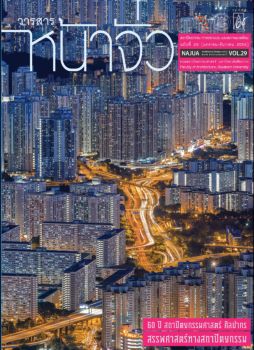คุณค่าและความหมายของลวดลายมงคล ในอาคารพาณิชย์ยุคแรก 4 จังหวัดริมแม่นํ้าโขง
Keywords:
ลวดลายมงคล, สถาปัตยกรรมจีนโพ้นทะเล, อาคารพาณิชย์, สัญศาสตร์, Auspicious patterns, Oversea Chinese architecture, Shophouse, SemioticsAbstract
การใชัศิลปะในสถาปัตยกรรมเพื่อมุ่งหวังความอยู่รอด ความอยูู่ดีมีสุขของตนและครอบครัว เป็นคำจำกัดความของจุดมุ่งหมายในการใช้ลวดลายต่างๆ ที่มีความหมายเป็นมงคล อันเป็นความเชื่อ ที่สืบทอดมาจากวัฒนธรรมการก่อสร้างของจีน ในอาคารพาณิชย์ที่ใช้เป็นที่ประกอบอาชีพและที่อยู่ อาศัยของคนจีนโพ้นทะเลทั่วไป รวมถึงพื้นที่ริมแม่นํ้าโขงของภาคตะวันออกเฉียงเหนือของไทย ที่เคย เป็นพื้นที่การค้าที่รุ่งเรืองเมื่อราว 50 ปีที่แล้ว หลังจากการอพยพเข้ามาตั้งถิ่นฐานในพื้นที่ดังกล่าวของ ชาวจีน ลวดลายที่ปรากฏในอาคารที่ยังเหลืออยู่ในปัจจุบัน แม้ว่าบางครั้งจะมีรูปแบบที่ไม่ซับซ้อน แต่รากอันเป็นที่มาของความหมายในลวดลายนั้นๆ ได้สะท้อนให้เห็นถึงความคาดหวังในการดำเนิน ชีวิตที่ราบรื่นและรุ่งเรืองในดินแดนที่ห่างไกลจากบ้านเกิด การให้ความหมายและความสำคัญใน บริบทปัจจุบัน จึงไม่ได้อยู่ที่ความประณีตสวยงามของลวดลาย แต่เป็นการสืบทอดความเชื่อและ วัฒนธรรมจีน ที่ได้ส่งผ่านจากรุ่นสู่รุ่นมาอย่างต่อเนื่องไม่ตํ่ากว่าสองพันปี ในบริบทที่ต่างออกไปจาก ถิ่นกำเนิด รวมถึงเป็นส่วนหนึ่งที่สำคัญของประวัติศาสตร์ท้องถิ่น ดังนั้นกระบวนการถ่ายทอดความ หมายและความสำคัญของลวดลายดังกล่าวใหผู้ที่เกี่ยวข้องได้รับรู้จะเป็นกลไกที่สำคัญอันหนึ่ง ในการ สร้างคุณค่าให้แก่อาคารและท้องถิ่นนั้นๆ อันจะนำไปสู่ความพยายามในการบำรุงรักษาและซ่อมแซม สภาพของอาคาร ให้คงอยู่ควบคู่ไปกับพัฒนาการของประวัติศาสตร์ท้องถิ่นในแต่ละชุมชนต่อไป
Significance and meaning in auspicious patterns of old Shophouses in 4 Provinces along the Mekong River
Warunee Wang, Ph.D.
Assistant Professor, Faculty of Architecture, Khonkaen University
The use of art in architecture aims of survival, well-being of their families is the definition of the auspicious pattern in Chinese construction culture. In shophouses of oversea Chinese were in general used as commercial purposes in the ground floor and for residence in the upper floor. This character also appeared in the trading area along the Mekong River, in the northeast of Thailand during its heyday around half a century ago. Although such pattern sometimes appears to be simple and sometimes unrefined, hower the root meaning of the pattern itself still reflects the expectation of a prosperous and smooth life. Therefore the meaning and significance in a modern context should not only focus on the refinements of the pattern, but the value of inherited beliefs and culture of oversea Chinese that has been continuing for many generations in a different context from their homeland, as well as an important part of the local history. The process of conveying meaning and significance of such patterns to related people should be an important device to demonstrate the building’s value. This will lead to the efforts for conservation and preservation of the buildings, along with the development of communities’ local heritage.





